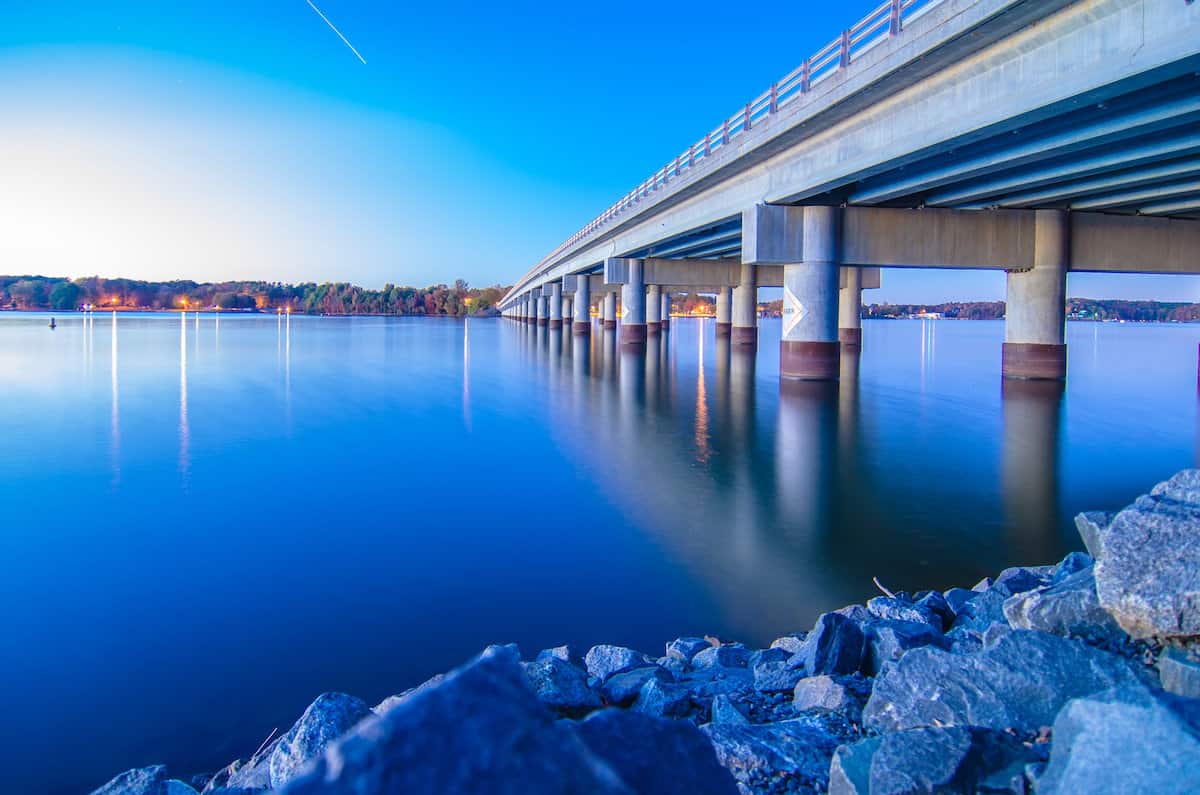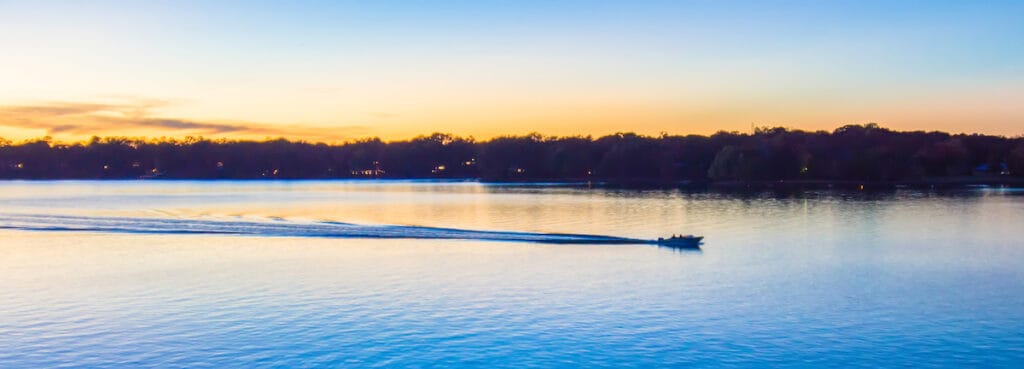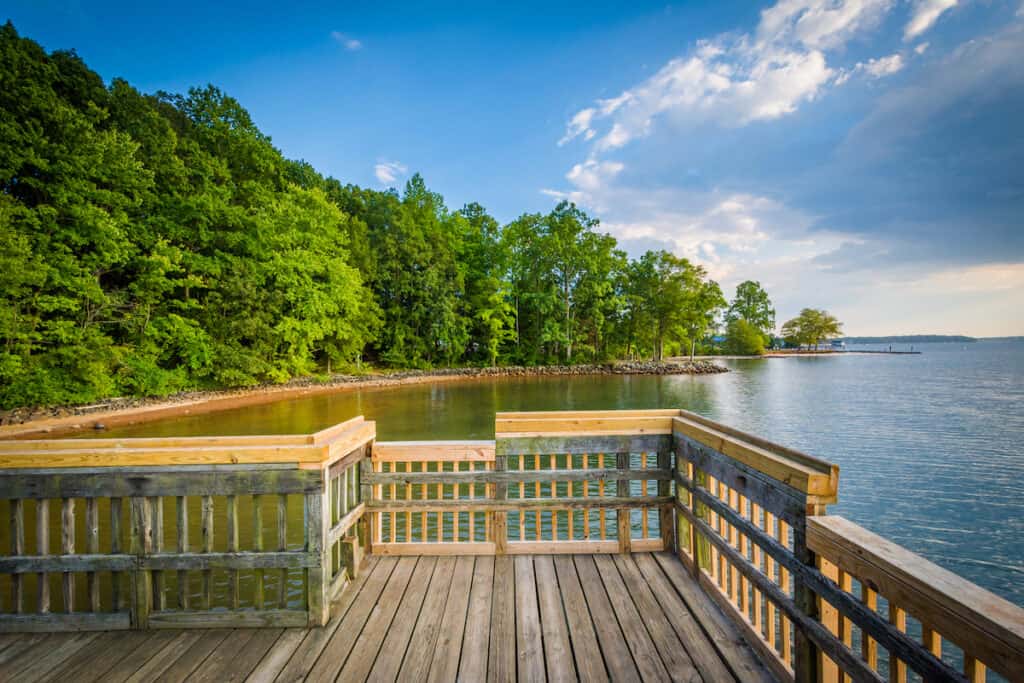Folks get excited about crappie fishing in a way that few other fish species can match. That’s pretty impressive, considering that most anglers regard any catch over 2 pounds as a trophy.
But these panfish are proof that size isn’t everything.
Whether you call them specks, calicoes or strawberry bass, there’s no doubt that North Carolina has some pretty incredible options when it comes to crappie fishing.
Two species of crappie call North Carolina waters home. Black crappie are widespread throughout the state, while white crappie are more at home in low-lying areas near the coast.
Black crappie also tend to favor clearer water, while white crappie are at home in murky locales.
Other than that, both species behave about the same, and one is as likely as the other to gobble up a lively minnow beneath a float or smack a small jig. These are the best lakes in North Carolina to catch them.
Jordan Lake
Jordan Lake is always part of the conversation about North Carolina’s best crappie lakes.
Regularly leading the pack for both crappie size and numbers, this 13,940-acre reservoir is less than a 30-minute drive from Raleigh and Durham, making it an extremely popular place.
Black crappies have an abundance of forage and prime spawning habitat in Jordan Lake, keeping their numbers fairly stable. Surveys by the Wildlife Resources Commission frequently reveal a population in which 30 percent of crappies are over 10 inches.
Jordan Lake is a checkmark-shaped reservoir with the Haw River and New Hope River forming its two principal arms. It also has numerous smaller creek arms and coves.
Those coves are where most of the crappie action takes place during the spring spawn in March and April. But some of the best crappie fishing is actually much earlier in the year.
In winter, crappies typically hold in 18- to 25-foot depths around deep brush piles and bridge pilings. Bridges across Jordan Lake are the best winter spots, especially the US-64 and Farrington Road bridges.
In February, crappies inch their way toward coves, often drawn by a temperature difference of just a degree or two.
Long-lining is an efficient search tactic in winter. It involves casting jigs behind the boat and trolling at around 1.2 miles per hour. Start in the deep part of a cove and work your way shallow.
Vertical jigging becomes a better tactic in March, when crappies are more concentrated in predictable shallow spots. Have a wide range of jig colors handy; red seems to work best when the water is muddy, but chartreuse is a go-to in all conditions.
In summer, crappies scatter. But they won’t go below the thermocline, and anglers still catch quite a few on deep creek channels and main lake points, along with brush piles and submerged road beds.
Long-lining is once again a good tactic to cover water in summer.
As the lake cools in fall, crappies will follow baitfish back into the coves, and there’s great crappie action along the creek channels leading into each cove.
The bridge between the Ebenezer Church Recreation Area boat ramp and the Beaver Creek pier is a key fall spot.
High Rock Lake
Located about halfway between Charlotte and Greensboro, High Rock Lake might be the best numbers lake for crappie in North Carolina. High Rock cranks out crappies in astonishing quantities.
They’re not all giants. High Rock offers both black and white crappies, and most years you can expect to catch a lot of fish measuring 8 or 9 inches, with occasional slabs in the 13- to 15-inch class.
High Rock Lake is a long, winding reservoir of 15,180 acres on the Yadkin River. It’s the best of the Yadkin River lakes for crappies and can produce good catches year-round.
Like most lakes, High Rock’s crappie fishing is best in spring.
March and April are prime months, with crappies transitioning from deep to shallow as the water warms into the 50s. The bite really goes into high gear at about 56°F.
Most of the lake’s coves are productive, with Flat Swamp Creek being the best known for crappies.
Expect the water to be muddy and debris-strewn early in the spring, and choose your presentation accordingly. Early in the season, long-lining with a Roadrunner Jig or similar lure that has some flash is effective.
Start at the creek channel and work your way toward the backs of the creeks until you find fish. Casting and vertical jigging are great tactics during the spawn, with Charlie Brewer’s Slider Jigs being local favorites.
High Rock Lake also has a great fall crappie bite, with docks and piers being key cover. Try skipping jigs under piers and “shooting” docks with a bow-and-arrow-like cast. Piers with adjacent brush in 6 to 10 feet of water are often best.
Kerr Lake (Buggs Island Lake)
Known as either Kerr Reservoir or Buggs Island Lake, depending on what side of the state line you’re on, Kerr Lake is a vast Roanoke River impoundment spanning 49,420 acres along the Virginia/North Carolina border.
While it’s an excellent all-around lake that brings lots of North Carolina anglers for largemouth bass and stripers, don’t forget about the crappie.
A lot of the best crappie fishing is on the Virginia side. But thanks to a reciprocal agreement between the two states, Tarheel anglers can fish anywhere on Kerr Lake by boat.
The first really good crappie fishing of the year starts in February around deep brush piles and bridge pilings, particularly at the upper end of the lake.
Local anglers and guides have sunk hundreds of brush piles and Christmas trees at a range of depths, mostly along the creek channels.
The crappie spawn begins at the upper end of the lake around Clarksville, VA, and makes its way gradually down to the lower end. March is the month to catch crappies as they’re getting ready to spawn.
You’ll find them staging on brush piles in the creeks in 8 to 12 feet of water right up until the right combination of factors triggers them to head into the backs of creeks. It can happen seemingly overnight.
Bluestone and Buffalo creeks are a couple of the best areas for spring crappies on Kerr Lake, along with Sandy Creek and Grassy Creek.
By summer, points at the mouths of creeks attract a lot of crappies, with the main lake stretch between Butcher and Eastland creeks being an especially good area.
Water level is a wild card on Kerr Lake, and the reservoir is prone to fluctuations as great as 25 feet. As you can imagine, that has a big impact on which areas are viable for crappie fishing at any given time.
More: Complete Guide to Fishing at Kerr Lake (Buggs Island)
Harris Lake
Harris Lake is just minutes away from Jordan Lake in the Piedmont area just west of Raleigh, and the two neighboring reservoirs are held in similar regard when it comes to crappie fishing.
At 4,100 acres, Harris is by far the smaller of the two, which can make it easier to pattern.
A spread-out lake with numerous creek arms and a primarily undeveloped shoreline, Harris Lake is mostly a black crappie fishery.
The water tends to be clear, so natural jig colors fare well. Start with different-colored jigs on multiple lines to see what the fish are vibing on any given day.
February into March will find crappies transitioning from timber-filled points into Harris Lake’s coves. This early period is the time to catch those 2-pound-plus giants.
But spring isn’t the only time to load up the livewill with crappies on Harris Lake.
Summer fishing can also be excellent, though finding fish is more than half the battle. You’re more likely to find crappies suspending around schools of baitfish this time of year.
Looking for bait balls on your electronics is the best way to pin down summertime crappies on Harris Lake. Long-lining with 1/16-ounce jig heads tipped with either crappie minnows or curly-tail jigs should entice them to bite.
There are some good winter options here, too.
During the colder months, focus on the east side of the lake, where the banks drop much more steeply than the west side. Pods of crappies often suspend along the steep bluff banks.
The stretch south of the Holleman boat ramp is often productive, with 25 to 35 feet being the typical depth.
Another spot to look for is the old submerged railway trestle, which crosses both the Little White Oak and Buckhorn arms.
Falls of the Neuse Lake
The Eno, Little and Flat rivers all converge to form Falls of the Neuse Lake, more often referred to simply as Falls Lake.
The reservoir itself is the source of the Neuse River, and it gets its name from its location right at the fall line between the Piedmont and the Coastal Plain.
Falls Lake is the third major crappie lake in the Raleigh-Durham area. And although Jordan and Harris lakes tend to get more credit, this 12,410-acre reservoir more than holds its own.
A lot of 2- and even 3-pound crappies are caught here in late winter and early spring.
From February through April, crappies follow classic patterns from pre-spawn to post-spawn, heading gradually from deep haunts to the backs of creeks and then back again.
Numerous creek arms on Falls Lake can be productive, but Ledge Creek is probably the most highly regarded. That’s especially the case early in the season because Ledge Creek is one of the first areas to warm up.
A submerged roadbed not far from the Ledge Creek boat ramp serves as a major crappie thoroughfare.
Big Lick Creek and Little Lick Creek are great, too, and the NC-50 bridge that spans the middle of the lake gets a lot of attention from crappie anglers in springtime.
In fall, a major threadfin shad migration heads up the Eno River branch of Falls Lake. This arm is the lake’s largest tributary and could be called its “main” branch.
Crappies follow the shad, making the upper end of the reservoir a killer spot for fall crappie fishing.
Focus on the stretch from the railroad trestle up to the Eno boat ramp in the fall. Depths range from 8 to 22 feet, and crappies often move back and forth between the river channel and nearby flats depending on the weather and the movements of the shad.
Lake Wylie
Snaking along 32 miles of the North Carolina/South Carolina Border, Lake Wylie is a crappie fishing powerhouse that ranks among the best in either state.
You’ll hear some say that this lake isn’t what it once was, but it still produces a whole lot of crappies.
Lake Wylie is a 13,400-acre reservoir on the Catawba River. Fed by numerous creeks as well as the main river, it offers classic crappie habitat, and the fish follow predictable patterns from winter through the spring spawn.
Life is easy from around Christmas time to February, when crappies stack up right around the mouths of Lake Wylie’s creeks, particularly on the deep side of humps and points next to the creek channel.
Larger, deeper creeks like Big Allison, Crowders and South Fork are best.
Crappies are there because baitfish are there; find bait, and you’ll find crappies. The best spots have water temperatures around 48 to 50 degrees this time of year, and might be 30 feet deep or more.
In late February and early March, the shallows start to warm up, and it’s a great time to be on the water.
Long-lining is the go-to tactic for many fishing this pre-spawn period, but tight-lining—slow trolling with heavier weights to keep one’s lines vertical—is also employed.
Exact timing varies from year to year, but crappies should be on their way into the creeks in March and heading back out in April. For anglers, it makes sense to do the same.
In March, start at the mouth of a creek and work your way in, either sticking to the middle of the creek or following parallel to the bank.
In April, when crappies are in various stages of spawn and post-spawn, start at the shallow back end of a creek and work your way out.
Lake Wylie’s shoreline is heavily developed, and dock fishing is a major pattern here.
Shooting jigs under docks accounts for a lot of fish, and the larger, longer docks that extend into deep water can be productive in all seasons.
Lake Wylie also made our rundown of the best catfish fishing lakes in North Carolina.
Honorable Mentions
Blewett Falls Lake
Blewett Falls Lake is the lowest of the chain of reservoirs known informally as the Yadkin Chain of Lakes, or the Uwharrie Lakes.
At 2,560 acres, it’s a fairly smal S-shaped lake that often gets overlooked, partly because it’s out in the middle of nowhere.
But news got around in the early aughts that anglers were catching crappies weighing 2, 3, even 4 pounds here, and suddenly Blewett Falls Lake started getting a lot more attention.
The fishing has dropped off a bit since then, but it’s still a solid choice in the Southern Piedmont.
Two major creeks on the west side of the lake, Smith Creek and Buffalo Creek, tend to be the focus of most crappie enthusiasts who fish here. In February, warmer weather and longer days draw crappies to the mouths of both creeks.
On the main lake, try the stretch between the big island and Smith Creek. There’s often a good bite far up at the river end of the main lake too, often in surprisingly shallow water.
Randleman Lake
Spanning just over 3,000 acres on the Deep River, Randleman Lake (also known as Randleman Reservoir) is one of North Carolina’s newer reservoirs. It opened to fishing for the first time in 2010, after being gradually filled over the span of several years.
This north-central North Carolina lake is best known for bass fishing. The Wildlife Resources Commission stocked both largemouth bass and channel catfish, but black crappie—which were never officially stocked here—quickly took off as well.
The lake has several bridge crossings, the pilings of which are some of the most productive crappie spots. Most bridges have riprap banks nearby, which regularly attract spring crappie.
There are some productive standing timber areas as well.
Randleman Lake is a water supply reservoir with some unique rules and restrictions; be sure to check the current regulations before you go. Powerboats are not allowed above the NC-62 bridge, making this area a great option for kayak anglers.
Lake Tillery
An often-underrated Yadkin River lake, Lake Tillery spans a little over 5,000 acres and lies just upriver from the aforementioned Blewett Falls Lake.
Tillery has always been a decent crappie lake, but the fishing seems to only be getting better.
Lake Tillery is predominantly a black crappie lake. During the pre-spawn period from February into March, one can often catch 1-pound crappies all day, with the occasional fish weighing 2 pounds and up.
Long-lining around the mouths of creeks is the go-to tactic early in the season. Depths range from 10 to 30 feet, and top spots include Mountain Creek and Woodrun Creek, both toward the lake’s upper end.
Jacobs, Swift Island, Cedar and Plantation creeks are also productive.
Once crappies shift into spawn mode, switch to dropping jigs into brush or shooting them under docks.
Later on, in summer, fishing can be very good for crappies suspending above the thermocline.
Lake Norman
Crappies may not be the first species that springs to mind when it comes to fishing Lake Norman, a phenomenal multi-species lake with great largemouth bass fishing.
The largest reservoir completely within state lines, Norman encompasses 32,510 acres on the Catawba River and is probably better known for bass and catfish.
But the crappie fishing here can also be phenomenal.
The trick is finding them, which can sometimes be challenging on such a vast lake. A good tip is to start at the upper end of Lake Norman, which has the largest concentration of crappies.
The shoreline of Lake Norman is quite developed, and the best pre-spawn crappie bite in March is around docks in 12 to 18 feet of water. Several marinas have large floating dock complexes that draw crappies like magnets in spring.
Two other good spots are the “hot holes” near the Marshall Steam Station and the McGuire Power Plant during the colder months. Bank access is available near both warm water discharges, and crappies commonly mingle with striped bass, white bass and perch.
Bank access is available to the warm water discharge just off NC-150, and crappies commonly mingle with striped bass, white bass and perch.
More: Complete Guide to Fishing Lake Norman
Tar River Reservoir
One of the best crappie lakes in eastern North Carolina, Tar River Reservoir is a long, snakelike lake on its namesake river, which meanders through Nash County not far from Rocky Mount.
It’s primarily known as a white crappie lake.
Tar River Reservoir has produced multiple state record white crappies over the years, including one that tipped the scales at 3 pounds, 12 ounces.
Springtime dock fishing accounts for some of the best crappie catches here.
Being just 694 acres in size, Tar River Reservoir has fewer options than many of North Carolina’s large reservoirs, but it’s a relatively easy lake to figure out.
The challenge is that conditions can change rapidly in spring, with rains bringing up the water level and turning it the color of chocolate milk.
Local experts use a slingshot-like method of shooting tiny jigs under docks using ultralight tackle. There are plenty of sunken brush piles in the lake, too, as well as numerous laydowns on less-developed sections of the lakeshore.
Catch More Crappie
Check out our comprehensive guide to the simplest and most effective crappie techniques.



